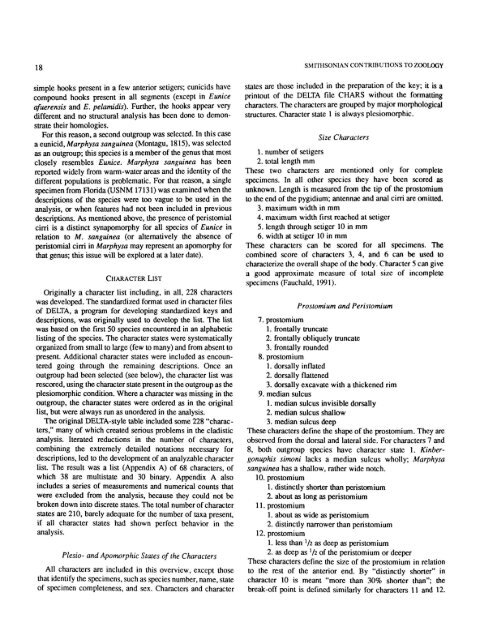A Review of the Genus Eunice - Smithsonian Institution Libraries
A Review of the Genus Eunice - Smithsonian Institution Libraries
A Review of the Genus Eunice - Smithsonian Institution Libraries
Create successful ePaper yourself
Turn your PDF publications into a flip-book with our unique Google optimized e-Paper software.
18<br />
SMITHSONIAN CONTRIBUTIONS TO ZOOLOGY<br />
simple hooks present in a few anterior setigers; eunicids have<br />
compound hooks present in all segments (except in <strong>Eunice</strong><br />
afuerensis and E. pelamidis). Fur<strong>the</strong>r, <strong>the</strong> hooks appear very<br />
different and no structural analysis has been done to demonstrate<br />
<strong>the</strong>ir homologies.<br />
For this reason, a second outgroup was selected. In this case<br />
a eunicid, Marphysa sanguinea (Montagu, 1815), was selected<br />
as an outgroup; this species is a member <strong>of</strong> <strong>the</strong> genus that most<br />
closely resembles <strong>Eunice</strong>. Marphysa sanguinea has been<br />
reported widely from warm-water areas and <strong>the</strong> identity <strong>of</strong> <strong>the</strong><br />
different populations is problematic. For that reason, a single<br />
specimen from Florida (USNM 17131) was examined when <strong>the</strong><br />
descriptions <strong>of</strong> <strong>the</strong> species were too vague to be used in <strong>the</strong><br />
analysis, or when features had not been included in previous<br />
descriptions. As mentioned above, <strong>the</strong> presence <strong>of</strong> peristomial<br />
cirri is a distinct synapomorphy for all species <strong>of</strong> <strong>Eunice</strong> in<br />
relation to M. sanguinea (or alternatively <strong>the</strong> absence <strong>of</strong><br />
peristomial cirri in Marphysa may represent an apomorphy for<br />
that genus; this issue will be explored at a later date).<br />
CHARACTER LIST<br />
Originally a character list including, in all, 228 characters<br />
was developed. The standardized format used in character files<br />
<strong>of</strong> DELTA, a program for developing standardized keys and<br />
descriptions, was originally used to develop <strong>the</strong> list. The list<br />
was based on <strong>the</strong> first 50 species encountered in an alphabetic<br />
listing <strong>of</strong> <strong>the</strong> species. The character states were systematically<br />
organized from small to large (few to many) and from absent to<br />
present. Additional character states were included as encountered<br />
going through <strong>the</strong> remaining descriptions. Once an<br />
outgroup had been selected (see below), <strong>the</strong> character list was<br />
rescored, using <strong>the</strong> character state present in <strong>the</strong> outgroup as <strong>the</strong><br />
plesiomorphic condition. Where a character was missing in <strong>the</strong><br />
outgroup, <strong>the</strong> character states were ordered as in <strong>the</strong> original<br />
list, but were always run as unordered in <strong>the</strong> analysis.<br />
The original DELTA-style table included some 228 "characters,"<br />
many <strong>of</strong> which created serious problems in <strong>the</strong> cladistic<br />
analysis. Iterated reductions in <strong>the</strong> number <strong>of</strong> characters,<br />
combining <strong>the</strong> extremely detailed notations necessary for<br />
descriptions, led to <strong>the</strong> development <strong>of</strong> an analyzable character<br />
list. The result was a list (Appendix A) <strong>of</strong> 68 characters, <strong>of</strong><br />
which 38 are multistate and 30 binary. Appendix A also<br />
includes a series <strong>of</strong> measurements and numerical counts that<br />
were excluded from <strong>the</strong> analysis, because <strong>the</strong>y could not be<br />
broken down into discrete states. The total number <strong>of</strong> character<br />
states are 210, barely adequate for <strong>the</strong> number <strong>of</strong> taxa present,<br />
if all character states had shown perfect behavior in <strong>the</strong><br />
analysis.<br />
Plesio- and Apomorphic States <strong>of</strong> <strong>the</strong> Characters<br />
All characters are included in this overview, except those<br />
that identify <strong>the</strong> specimens, such as species number, name, state<br />
<strong>of</strong> specimen completeness, and sex. Characters and character<br />
states are those included in <strong>the</strong> preparation <strong>of</strong> <strong>the</strong> key; it is a<br />
printout <strong>of</strong> <strong>the</strong> DELTA file CHARS without <strong>the</strong> formatting<br />
characters. The characters are grouped by major morphological<br />
structures. Character state 1 is always plesiomorphic.<br />
Size Characters<br />
1. number <strong>of</strong> setigers<br />
2. total length mm<br />
These two characters are mentioned only for complete<br />
specimens. In all o<strong>the</strong>r species <strong>the</strong>y have been scored as<br />
unknown. Length is measured from <strong>the</strong> tip <strong>of</strong> <strong>the</strong> prostomium<br />
to <strong>the</strong> end <strong>of</strong> <strong>the</strong> pygidium; antennae and anal cirri are omitted.<br />
3. maximum width in mm<br />
4. maximum width first reached at sctigcr<br />
5. length through setiger 10 in mm<br />
6. width at sctigcr 10 in mm<br />
These characters can be scored for all specimens. The<br />
combined score <strong>of</strong> characters 3, 4, and 6 can be used to<br />
characterize <strong>the</strong> overall shape <strong>of</strong> <strong>the</strong> body. Character 5 can give<br />
a good approximate measure <strong>of</strong> total size <strong>of</strong> incomplete<br />
specimens (Fauchald, 1991).<br />
Prostomium and Peristomium<br />
7. prostomium<br />
1. frontal ly truncate<br />
2. frontally obliquely truncate<br />
3. frontally rounded<br />
8. prostomium<br />
1. dorsally inflated<br />
2. dorsally flattened<br />
3. dorsally excavate with a thickened rim<br />
9. median sulcus<br />
1. median sulcus invisible dorsally<br />
2. median sulcus shallow<br />
3. median sulcus deep<br />
These characters define <strong>the</strong> shape <strong>of</strong> <strong>the</strong> prostomium. They are<br />
observed from <strong>the</strong> dorsal and lateral side. For characters 7 and<br />
8, both outgroup species have character state 1. Kinbergonuphis<br />
simoni lacks a median sulcus wholly; Marphysa<br />
sanguinea has a shallow, ra<strong>the</strong>r wide notch.<br />
10. prostomium<br />
1. distinctly shorter than peristomium<br />
2. about as long as peristomium<br />
11. prostomium<br />
1. about as wide as peristomium<br />
2. distinctly narrower than peristomium<br />
12. prostomium<br />
1. less than x li as deep as peristomium<br />
2. as deep as x li <strong>of</strong> <strong>the</strong> peristomium or deeper<br />
These characters define <strong>the</strong> size <strong>of</strong> <strong>the</strong> prostomium in relation<br />
to <strong>the</strong> rest <strong>of</strong> <strong>the</strong> anterior end. By "distinctly shorter" in<br />
character 10 is meant "more than 30% shorter than"; <strong>the</strong><br />
break-<strong>of</strong>f point is defined similarly for characters 11 and 12.
















